Pokémon Sword and Shield – EV Training Guide
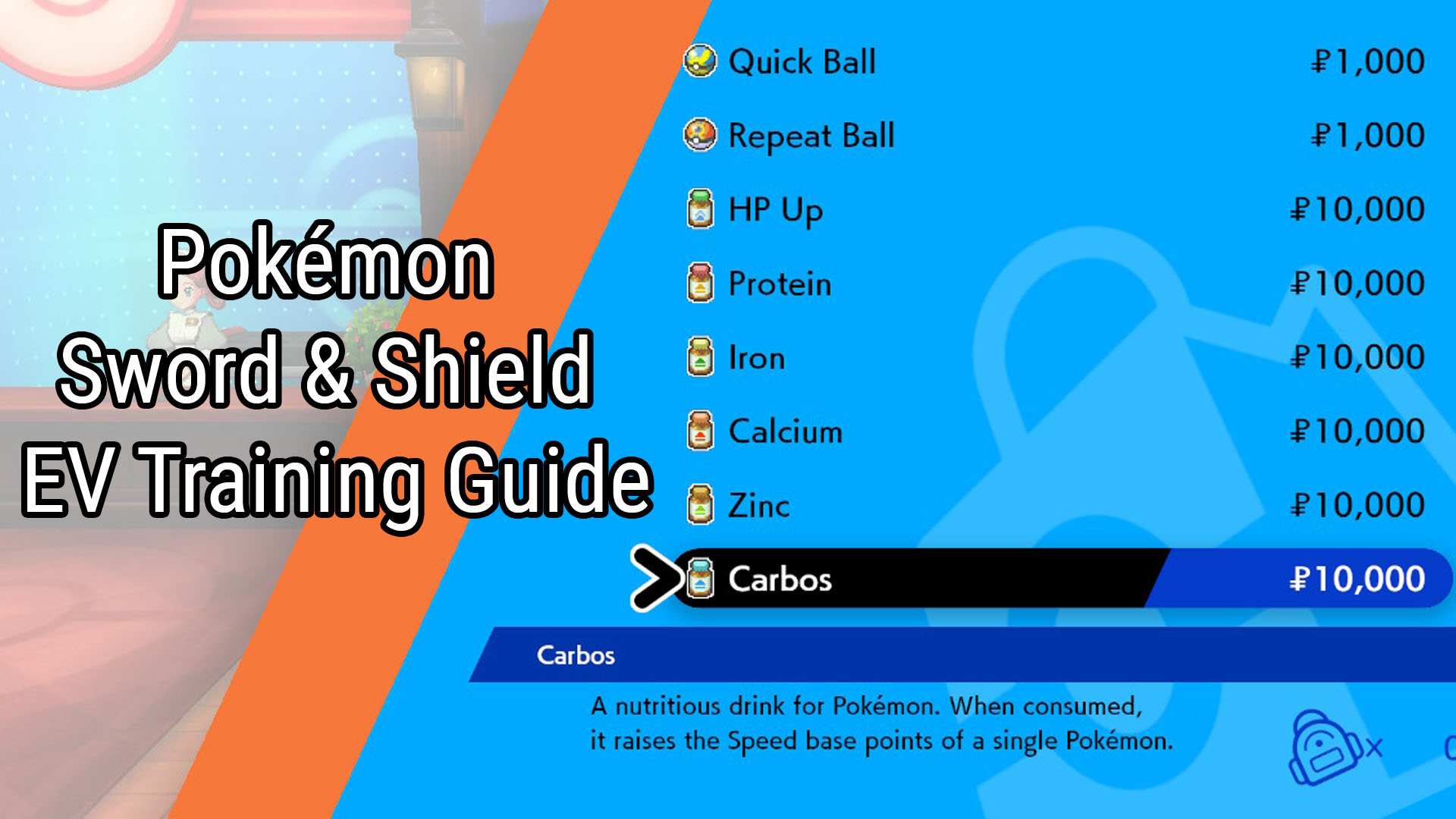
EV training in Sun and Moon was made relatively simple thanks to the chaining mechanic. In Sword and Shield, however, things are rather different: defeating wild Pokémon for EV gains is still an alternative, but it is far from the most optimal method. Read on to learn the best ways to EV train in Generation 8!
EV Basics
EVs, sometimes referred to in-game as “base points,” stands for Effort Values. Each Pokémon has a total of 508 EVs to distribute freely in its stats. There is not only a cap on how many EVs each Pokémon can have total, but also a cap on the maximum allowed EV investment in each stat: 252 EVs per stat.
So what do EVs do, exactly? You guessed it: they confer stat bonuses! Specifically, for every 4 EVs you invest in a stat, you gain 1 stat point at level 100. Why at level 100, you ask? Well, imagine if you could confer a massive stat bonus to a level 1 Pokémon—since each stat is worth more at such a low level, the EV system would be quite overpowered! For that reason, both EVs and IVs are distributed based on each Pokémon’s level.
At level 50 (which is the level Pokémon in VGC are automatically set to), EVs generally need to be on the form of 4 + 8n, which is just a fancier way of saying that the remainder when divided by 8 should be 4. Another way of looking at it is that the first 4 EVs in a stat will give a stat bonus of 1, and from there you will need to invest 8 EVs for each additional stat bonus. So, for example, 4, 12, and 20 are valid “EV numbers” at level 50, but 8 or 16 are not.
In Sword and Shield, you can see a rough estimation of the EVs a Pokémon has by going to its Stats page and pressing the X button. If you see sparkles around one of the stats, it means the EVs in that stat are maxed out!
Power Items
Before you start EV training, you may want to grab the six Power items. When equipped with a Power item, a Pokémon’s EV gain is increased by 8 per battle or job.
Power items each correspond to a stat as follows:
- HP – Power Weight
- Attack – Power Bracer
- Defense – Power Belt
- Special Attack – Power Lens
- Special Defense – Power Band
- Speed – Power Anklet
These can all be purchased in Hammerlocke for 10 BP each. If you’re in need of BP, I suggest running through the Battle Tower in Wyndon. This is quite easy to do with a rental team, such as the Rain rental team available in-game. You could also simply power through the Battle Tower with legendaries, as they’re not banned from use.
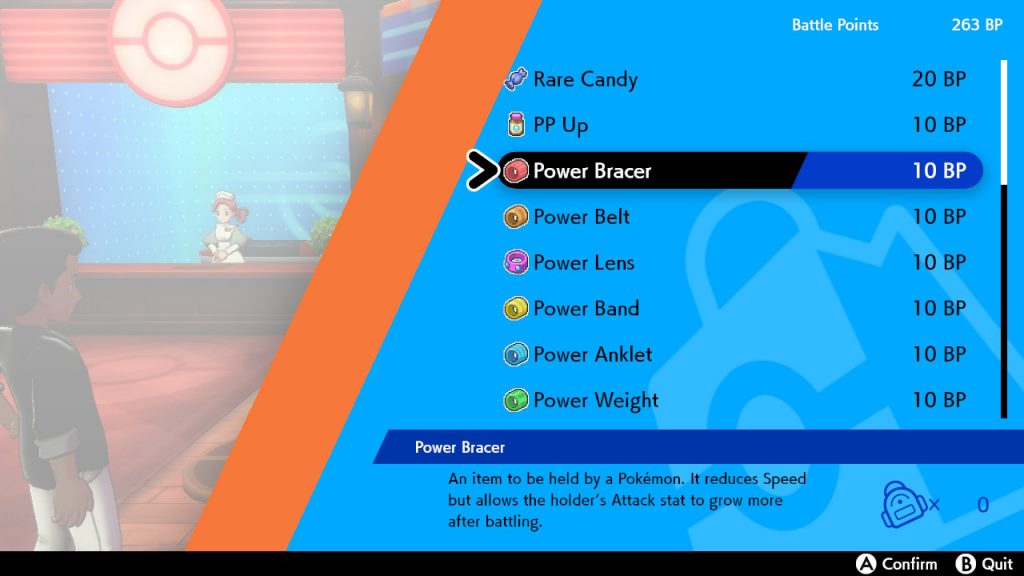
The BP Shop in Hammerlocke sells the six Power items.
PokéRus
PokéRus is a purely beneficial virus which doubles the EVs received by infected Pokémon. The virus has a chance to be spread to adjacent Pokémon in your party each time you enter battle. It doesn’t matter what you do during battle, so you can simply encounter wild Pokémon and run away until your project Pokémon has the virus. Since the PokéRus is exceptionally rare, you will usually have to trade with someone else to obtain it!
While the doubled EV effect granted by the PokéRus never goes away, the ability to infect other Pokémon will disappear from all Pokémon in your party once the Switch clock hits midnight. Pokémon in the PC are not bound by this rule. For this reason, you always want to keep a Pokémon with the ability to spread PokéRus to other Pokémon in your PC.
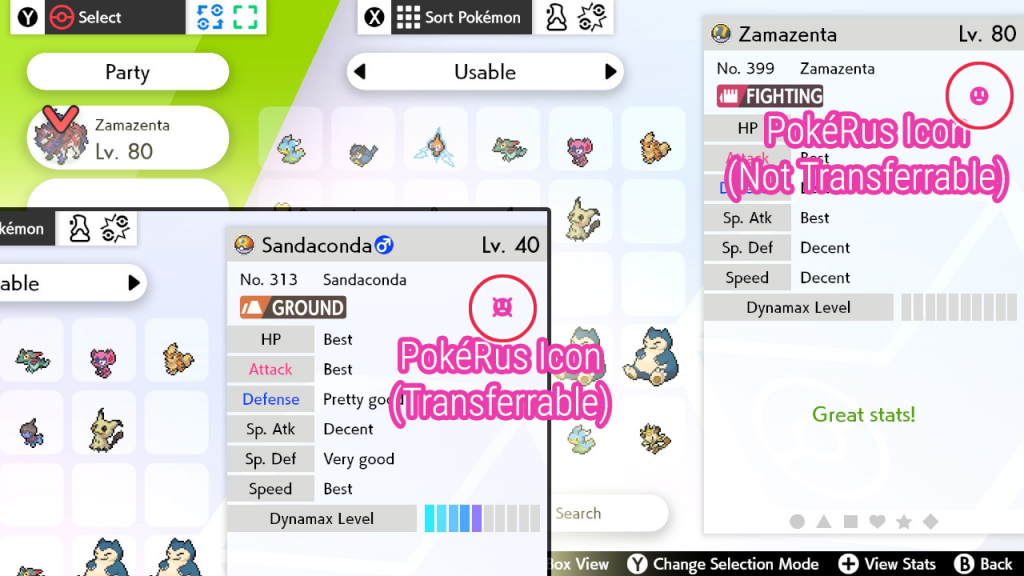
The PokéRus icon changes depending on whether or not the Pokémon is able to transfer its virus. Even Pokémon which can no longer infect others receive doubled EVs!
PokéJobs
PokéJobs are a new feature in Sword and Shield which allows you to send out your Pokémon on various jobs. After a certain amount of time has passed, the Pokémon will return, having found items, gained more EXP, or—of most relevance to this guide!—gained more EVs.
You can choose the amount of time you want your Pokémon to spend at a PokéJob, ranging from “a little while” to “whole day”. Since the game is rather vague about explaining how much time needs to pass in real life in order for a job to complete, refer to the list below to understand what each in-game phrase means:
- A little while – 1 hour
- Very short – 2 hours
- Short – 3 hours
- Long – 4 hours
- Very long – 8 hours
- Half day – 12 hours
- Whole day – 24 hours
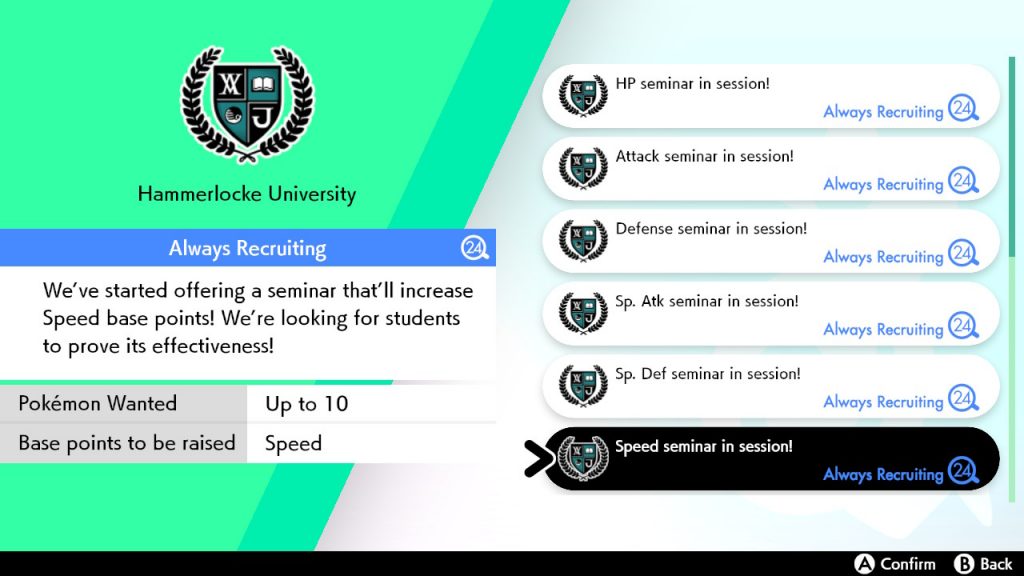
Send your Pokémon on the Hammerlocke University jobs to receive EVs (referred to by the game as “base points”)!
PokéJob EV Yields
PokéJobs yield 4 EVs per hour for the Pokémon you send on them, but the EV gain is affected by both PokéRus and held items (such as the Power items). The maximum yield would be 24 EVs per hour and is achieved by letting a Pokémon with PokéRus hold a Power item. The EV yield in a stat will, of course, cap out at 252 EVs, so sending a Pokémon with PokéRus and a Power item on a 12-hour long PokéJob will cause them to come back with 252 EVs (as opposed to 288).
Yields depending on time and modifiers are listed below:
| Time | Base EV yield | Yield with PokéRus | Yield with Power item | Yield with PokéRus and Power item |
|---|---|---|---|---|
| A little while (1 hr) | 4 | 8 | 12 | 24 |
| Very short (2 hrs) | 8 | 16 | 24 | 48 |
| Short (3 hrs) | 12 | 24 | 36 | 72 |
| Long (4 hrs) | 16 | 32 | 48 | 96 |
| Very long (8 hrs) | 32 | 64 | 96 | 192 |
| Half day (12 hrs) | 48 | 96 | 144 | 252 |
| Whole day (24 hrs) | 96 | 192 | 252 | 252 |
Making Jobs Finish Instantly
At a glance, PokéJobs may not seem the best method for EV training as they function similarly to the PokéPelago in that they require a certain amount of time to pass before your Pokémon will gain EVs. Sword and Shield, however, happens to have a very handy glitch that tricks the game into thinking a certain amount of time has passed. This will update any time-based events, including PokéJobs. Making use of this exploit is by far the fastest way to gain EVs in Sword and Shield.
Simply send your Pokémon on a PokéJob, then make a day pass by using the Raid den trick. With this method, you can max out several of your Pokémon’s EVs almost instantly!
Vitamins
Vitamins are items which raise your Pokémon’s EVs in a stat by 10. Previously, vitamins could not be used once a Pokémon had reached 100 EVs in a stat, but Sword and Shield allows you to EV train your Pokémon using vitamins even after reaching 100 EVs in a stat. It’s now entirely possible to EV train your Pokémon using only vitamins!
The following vitamins correspond to the following stats:
- HP Up – Raises HP by 10 EVs
- Protein – Raises Attack by 10 EVs
- Iron – Raises Defense by 10 EVs
- Calcium – Raises Special Attack by 10 EVs
- Zinc – Raises Special Defense by 10 EVs
- Carbos – Raises Speed by 10 EVs
Vitamins can be bought with money in the Wyndon Pokémon Center or with BP in Hammerlocke.
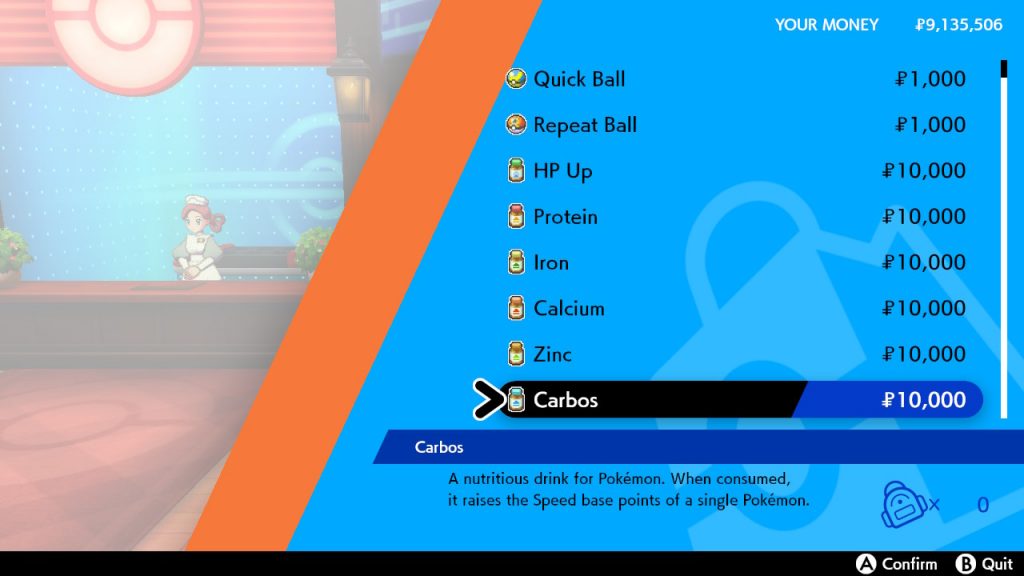
Vitamins come at a hefty price!
In Need of More PokéDollars?
Money is easy to farm by using the Raid den trick (which allows you to convert Watts into PokéDollars); this trick allows you to make millions of PokéDollars in less than half an hour.
“Find a den and throw in a Wishing Piece. Make sure you’re offline before continuing. Next, interact with the den and click the Invite Others option. As the timer starts ticking down, use the Home button to access the System Settings. From here, go to the System tab, then to Date and Time. If your date is synced via the Internet, turn the option off before proceeding. Change the date to a different day—the day you choose doesn’t matter (for simplicity’s sake, I recommend simply setting the date to the next day).
Go back to the game and Quit looking for other players. With the date changed, the raid spawn will update, but the rarity of the den will stay the same as it was. You’ve successfully tricked the game into believing a day or more has passed, which causes Raid dens to update and yield Watts once more.”
Once you’ve got the needed Watts, simply find a Wild Area vendor selling Luxury Balls, buy as many of them as you can carry, and sell them. Simple!
Buying vitamins with PokéDollars is generally preferable to spending BP on them, as making money is considerably easier than getting BP. If you dislike the thought of using a glitch to make in-game money, your next best bet is using Gigantamax Meowth, which can be obtained via Mystery Gift until January 15th, 2020. If you missed this Mystery Gift event, you’ll have to trade!
Once you’ve got your Meowth, you’ll ideally want to get it to level 100 to take out opposing Pokémon easier and maximize money gain. Equip Meowth with an Amulet Coin or Luck Incense and ensure it knows a damaging Normal-type move. Now, start a Champion Cup tournament in the Wyndon Stadium. In each match, lead with Gigantamax Meowth and use G-Max Gold Rush three times. You should earn a bonus 99,9999 PokéDollars per match from the G-Max Move, on top of the smaller amount of money gained from defeating each trainer.
Wild Pokémon
Each time you gain EXP from defeating a Pokémon, you will also gain a certain amount of EVs; the stat and amount varies depending on the Pokémon defeated. With chaining gone, EV training by defeating wild Pokémon is a much slower process than before. Regardless, it’s a good way to top up the last few EVs you might need for a specific spread after using one of the above two methods to get as close to it as possible.
When using this EV training method, you may want to equip your project Pokémon with a Power item and infect it with PokéRus, depending on the amount of EVs needed. If you’re EV training entirely by defeating wild Pokémon, doing so is optimal to maximize EV gain: you would gain 18 EVs by defeating a Pokémon that normally yields 1 EV, or 20 EVs if they normally yield 2 EVs.
EV Training Hotspots
The following is a list of ideal locations for EV training specific stats in Sword and Shield, alongside the EVs yielded by each Pokémon when defeated (all listed Pokémon spawn in the overworld):
- HP – Skwovet (+1 EV), Route 1 / Noctowl (+2 EVs), Motostoke Outskirts
- Attack – Stufful (+1 EV), Route 5 / Perrserker (+2 EVs), Route 7
- Defense – Rolycoly (+1 EV), Route 3 near Galar Mine entrance / Pelipper (+2 EVs), Route 9 near Circhester
- Special Attack – Snom (+1 EV), Route 8 on Steamdrift Way near Circhester
- Special Defense – Gossifleur (+1 EV), Route 3 near Motostoke
- Speed – Arrokuda (+1 EV) or Barraskewda (+2 EVs), Route 2 in water to the right of Professor Magnolia’s house / Zigzagoon (+1 EV), Route 3 near Motostoke




